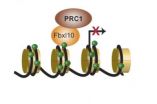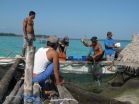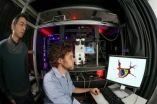(Press-News.org) The hippocampus – a structure of the brain whose shape resembles that of a seahorse – is also called the "gateway" to memory. This is where information is stored and retrieved. Its performance relies on new neurons being continually formed in the hippocampus over the entire lifetime. "However, in old age, production of new neurons dramatically decreases. This is considered to be among the causes of declining memory and learning ability", Prof. Dr. Ana Martin-Villalba, a neuroscientist, explains.
Martin-Villalba, who heads a research department at the German Cancer Research Center (DKFZ), and her team are trying to find the molecular causes for this decrease in new neuron production (neurogenesis). Neural stem cells in the hippocampus are responsible for continuous supply of new neurons. Specific molecules in the immediate environment of these stem cells determine their fate: They may remain dormant, renew themselves, or differentiate into one of two types of specialized brain cells, astrocytes or neurons. One of these factors is the Wnt signaling molecule, which promotes the formation of young neurons. However, its molecular counterpart, called Dickkopf-1, can prevent this.
"We find considerably more Dickkopf-1 protein in the brains of older mice than in those of young animals. We therefore suspected this signaling molecule to be responsible for the fact that hardly any young neurons are generated any more in old age." The scientists tested their assumption in mice whose Dickkopf-1 gene is permanently silenced. Professor Christof Niehrs had developed these animals at DKFZ. The term "Dickkopf" (from German "dick" = thick, "Kopf" = head) also goes back to Niehrs, who had found in 1998 that this signaling molecule regulates head development during embryogenesis.
Martin-Villalba's team discovered that stem cells in the hippocampus of Dickkopf knockout mice renew themselves more often and generate significantly more young neurons. The difference was particularly obvious in two-year old mice: In the knockout mice of this age, the researchers counted 80 percent more young neurons than in control animals of the same age. Moreover, the newly formed cells in the adult Dickkopf-1 mutant mice matured into potent neurons with multiple branches. In contrast, neurons in control animals of the same age were found to be more rudimentary already.
Blocking Dickkopf improves spatial orientation and memory
Several years ago, Ana Martin-Villalba had shown that mice lose their spatial orientation when neurogenesis in the hippocampus is blocked. Now, is it possible that the young neurons in Dickkopf-deficient mice improve the animals' cognitive performance? The DKFZ researchers used standardized tests to study how the mice orient themselves in a maze. While in the control animals, the younger ones (3 months) performed much better in orienting themselves than the older ones (18 months), the Dickkopf-1-deficient mice showed no age-related decline in spatial orientation capabilities. Older Dickkopf-1 mutant mice also outperformed normal animals in tests determining spatial memory.
"Our result proves that Dickkopf-1 promotes age-related decline of specific cognitive abilities," says Ana Martin-Villalba. "Although we had expected silencing of Dickkopf-1 to improve spatial orientation and memory of adult mice, we were surprised and impressed that animals in advanced adult age actually reach the performance levels of young animals."
These results give rise to the question whether the function of Dickkopf-1 may be turned off using drugs. Antibodies blocking the Dickkopf protein are already being tested in clinical trials for treating a completely different condition. "It is fascinating to speculate that such a substance may also slow down age-related cognitive decline. But this is still a dream of the future, since we have only just started first experiments in mice to explore this question."
INFORMATION:
Désirée R.M. Seib, Nina S. Corsini, Kristina Ellwanger, Christian Plaas, Alvaro Mateos, Claudia Pitzer, Christof Niehrs, Tansu Celikel and Ana Martin-Villalba: Loss of Dickkopf-1 restores neurogenesis in old age and counteracts cognitive decline. Cell Stem Cell 2013, DOI: 10.1016/j.stem.2012.11.010
A picture for this press release is available at:
http://www.dkfz.de/de/presse/pressemitteilungen/2013/images/Villalba_Hippocampus.jpg
Picture caption: Newborn neurons (in green) in the brain of a 3 month old mouse
Picture source: German Cancer Research Center
The German Cancer Research Center (Deutsches Krebsforschungszentrum, DKFZ) with its more than 2,500 employees is the largest biomedical research institute in Germany. At DKFZ, more than 1,000 scientists investigate how cancer develops, identify cancer risk factors and endeavor to find new strategies to prevent people from getting cancer. They develop novel approaches to make tumor diagnosis more precise and treatment of cancer patients more successful. The staff of the Cancer Information Service (KID) offers information about the widespread disease of cancer for patients, their families, and the general public. Jointly with Heidelberg University Hospital, DKFZ has established the National Center for Tumor Diseases (NCT) Heidelberg, where promising approaches from cancer research are translated into the clinic. In the German Consortium for Translational Cancer Research (DKTK), one of six German Centers for Health Research, DKFZ maintains translational centers at seven university partnering sites. Combining excellent university hospitals with high-profile research at a Helmholtz Center is an important contribution to improving the chances of cancer patients. DKFZ is a member of the Helmholtz Association of National Research Centers, with ninety percent of its funding coming from the German Federal Ministry of Education and Research and the remaining ten percent from the State of Baden-Württemberg.
END
(SACRAMENTO, Calif.) — Scientists have long puzzled over why "bad" bacteria such as E. coli can thrive in the guts of those with inflammatory bowel disease (IBD), causing serious diarrhea. Now UC Davis researchers have discovered the answer—one that may be the first step toward finding new and better treatments for IBD.
The researchers discovered a biological mechanism by which harmful bacteria grow, edge out beneficial bacteria and damage the gut in IBD. This new understanding, published in the Feb. 8 issue of Science, may help researchers develop new treatments for ...
Jacob Rutt is a bright 11-year-old who likes to draw detailed maps in his spare time. But the budding geographer has a hard time with physical skills most children take for granted -- running and climbing trees are beyond him, and even walking can be difficult. He was diagnosed with a form of muscular dystrophy known as Duchenne when he was two years old.
The disease affects about 1 in 3,500 newborns -- mostly boys -- worldwide. It usually becomes apparent in early childhood, as weakened skeletal muscles cause delays in milestones such as sitting and walking. Children ...
A single embryonic stem cell can develop into more than 200 specialized cell types that make up our body. This maturation process is called differentiation and is tightly regulated. If the regulation is lost, specialized cells cannot develop correctly during development. In adulthood, the specialized cells may forget their identity and develop into cancer cells. Research from BRIC, University of Copenhagen, has identified a crucial role of the molecule Fbxl10 in differentiation of embryonic stem cells and suggests the molecule as a new potential target for cancer therapy.
"Our ...
Highlights of this news release:
Six-month study finds that progestin-releasing contraceptives show a slight negative impact on metabolic markers, raising the risk for type 2 diabetes.
Contraceptive implants under the skin increase the risk more than uterine implants.
Longer and larger studies are needed to see if metabolic changes are temporary or long-term.
LOS ANGELES – A first-of-its-kind study by researchers at the Keck School of Medicine of the University of Southern California (USC) indicates that healthy, obese, reproductive-age women who use long-acting ...
Fishing communities living on the islands of Indonesia's Karimunjawa National Park have found an important balance, improving their social well-being while reducing their reliance on marine biodiversity, according to the Wildlife Conservation Society and the University of Western Australia.
Over the past 5 years, the Government of Indonesia has turned Karimunjawa National Park—a marine paradise of turquoise seas and mangrove-ringed islands in the Java Sea just south of Borneo—into a model of co-management for the country, largely by increasing community participation ...
ARGONNE, Ill. – Although scientists have been aware that magnetism and electricity are two sides of the same proverbial coin for almost 150 years, researchers are still trying to find new ways to use a material's electric behavior to influence its magnetic behavior, or vice versa.
Thanks to new research by an international team of researchers led by the U.S. Department of Energy's Argonne National Laboratory, physicists have developed new methods for controlling magnetic order in a particular class of materials known as "magnetoelectrics."
Magnetoelectrics get their ...
Triple-negative breast cancer is an aggressive form of breast cancer that has few treatment options;
This large-scale study shows that abnormal levels of small molecules called microRNA can be used to classify this malignancy into four subtypes;
The findings could lead to new ways to identify the best therapy for individual patients and to more effective therapies in the future.
COLUMBUS, Ohio – A new, large-scale study of triple-negative breast cancer shows that small molecules called microRNA can be used to define four subtypes of this aggressive malignancy.
The ...
In the world of microscopy, this advance is almost comparable to the leap from photography to live television. Two young EPFL researchers, Yann Cotte and Fatih Toy, have designed a device that combines holographic microscopy and computational image processing to observe living biological tissues at the nanoscale. Their research is being done under the supervision of Christian Depeursinge, head of the Microvision and Microdiagnostics Group in EPFL's School of Engineering.
Using their setup, three-dimensional images of living cells can be obtained in just a few minutes ...
WASHINGTON –Requiring individuals to pay a premium for public health insurance coverage can counteract the coverage effects of expanding eligibility for public health insurance programs to higher income families.
That is the finding of a study by a team of researchers from Georgetown University School of Nursing & Health Studies (NHS), University of California at Los Angeles (UCLA), and Columbia University published today in the journal Health Services Research.
"Our findings speak to the importance of not just the availability of insurance coverage, but also the ...
Bronchiectasis is independently associated with an increased mortality risk in patients with moderate-to-severe COPD, according to a new study from researchers in Spain.
Bronchiectasis, a permanent and progressive dilation of the lung's airways, is common in COPD patients and is associated with longer and more intense exacerbations, more frequent bacterial colonization of the bronchial mucosa, and a greater degree of functional impairment.
"As COPD patients with bronchiectasis have an increased incidence of other known prognostic factors, we hypothesized that bronchiectasis ...


